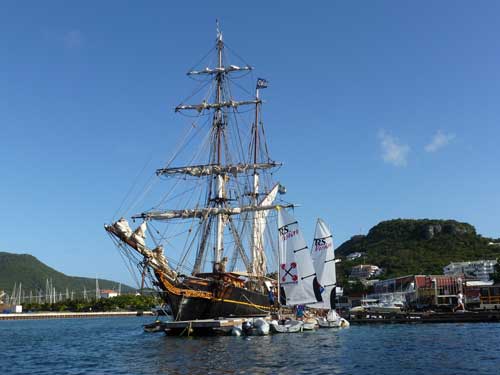
Moving freight under sail
In February crowds gathered at the St Maarten Yacht Club (SMYC) to watch Tres Hombres – a 32-meter engineless brigantine – pass through the Simpson Bay Bridge. Despite delays, due to the engineless vessel struggling in gusty winds, the brigantine was given a warm and friendly welcome by spectators and mega yachts alike.
With the brigantine safely tied alongside the SMYC dock, the gangplank was lowered and guests welcomed aboard as part of a ‘maritime experience day’. This was co-hosted by the SMYC and Maritime School of the West Indies, and co-sponsored by the Caribbean Sail Training Association, in order to learn more about this traditional sailing ship.
Regardless of its small size for a tall-ship, Tres Hombres has some lofty goals. The vessel is the brain child of three friends: Jorne Langelaan, Arjen Boogie Van Der Veen and Andreas Lackner (hence the name) and their aim is to provide and promote a more environmentally friendly method of transporting goods. In a time when the price of oil is rocketing and carbon footprints in the shipping industry are huge (one resource – TEDX Amsterdam, claim that 16 of the largest ships produce as much emissions as all the cars in the world), an alternative needs to be found. With this in mind Tres Hombres, a cargo ship focusing on the concept of sustainable shipping, was born.
The ship has an interesting history. Originally a 1943 German mine sweeper, which had been written off for scrap, it was found that her clipper lines would lend themselves to the project. The boat was converted and refitted and, in 2007, rigged as a brigantine. In 2009 she left Holland and went into service. One of her first jobs included taking supplies and aid across the Atlantic to Haiti. She now sails the Atlantic carrying cargo in a green and eco-friendly way, sometimes visiting ports that larger and deeper draft vessels wouldn’t get to, thus extending a hand to small local communities with fragile infrastructures.
The ship also offers sail training opportunities to young people, teaching them traditional sailing and seamanship, navigation, sail handling and maintenance.
Tres Hombres is the prototype for a ‘new’ breed of sailing cargo transport; reflecting the grand old days of sail. With no engine, the ship relies solely on the wind for propulsion, qualifying its cargo as transported in a 100%, CO2-free way. She has two wind generators, two solar panels and a towed generator. They do keep a generator for emergencies and to run an air conditioning unit for heat sensitive items in the hold, like the Grenadian chocolate that they were transporting to New York. Apart from a few modern navigation and communication aids, the ship keeps a very traditional stance. I was shown around by a friendly Austrian called Tobi. He told me that the ship is flying the ensign of Sierra Leone due to regulations prohibiting a vessel of its type (a vessel of its size with no engine) from registering in Europe. On the foredeck a huge, new, traditionally styled manual windless takes up most of the deck. The crews’ sleeping quarters in the fo’c’s’le seemed dark and dingy, the beds unmade. The galley is very basic with a household gas cooker and no more than a few feet of work-space, a water butt at one end and a tiny mess table. Water for washing up is on deck. Tools and spares are crammed into lockers. Some of the spaces, in which the crew moves around, are tiny. But then I remember that they are young; the sense of adventure and purpose in taking part in such a worthwhile project probably far outweighs the need for a tidy bed. And it’s easy to see that Captain Jorne Langelaan, one of the three friends, runs a tight ship; lines are coiled neatly and hang from their belaying pins and the decks are free of clutter. The rigging looks in good condition. The chart room is orderly and the officers’ mess is neat and tidy.
Other projects are underway to further this new breed of ‘sustainable transport’. The Ecoliner will be the first of a new generation of freighters with fully automated computer controlled sails. It will match the times of regular cargo ships by relying not only on the wind but also on bio fuel.
For more information on sustainable shipping or to request a freight price, visit: www.fairtransport.eu
For information about Tres Hombres and sail training, visit: www.svtreshombres.homestead.com
Rosie and her husband Sim Hoggarth, both from the UK, have cruised the Caribbean and North America for the last seven years on Alianna their Corbin39.




